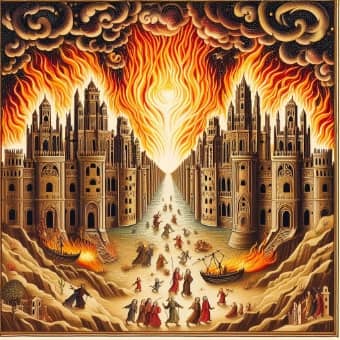Uncovering the Tale of Sodom and Gomorrah
Lessons from Biblical History
The story of Sodom and Gomorrah is a poignant narrative embedded within the tapestry of biblical history, offering insights into the nature of sin, judgment, and divine mercy. These ancient cities have been synonymous with sin and divine retribution, and over time, their story has woven itself into the moral fabric of many cultures and religions.
This account is primarily found in Genesis 19, which provides not only a historical lesson but also a moral compass for many believers.
This blog post contains affiliate links. When you click on a link on this page and make a purchase I may earn a small commission, at no additional cost to you. Thank you for your support.
The Setting of Sodom and Gomorrah
Sodom and Gomorrah were two cities situated on the plain of Jordan, and they were known for their prosperity due to the fertile land and trade opportunities. However, despite this abundance, the inhabitants of these cities were notorious for their grievous sins.
The Bible highlights their pride, gluttony, and widespread sexual immorality, including homosexuality, and how these practices were in opposition to the laws that God had laid out for righteous living.

Divine Intervention Through Angels
The biblical narrative unfolds with God sending two angels to Sodom, where Abraham’s nephew Lot resided. The angels were to evaluate the depth of the city’s depravity and execute judgment as deemed appropriate.
Lot, aware of the danger his guests faced from the lawless men of Sodom, offered them protection in his home, displaying his righteousness in contrast to the wickedness surrounding him.
Lot’s Hospitality and the Warning of Doom
Lot’s earnest hospitality is met with hostility as the men of Sodom surround his house, demanding to have their way with his visitors. In a protective stance, Lot offers his own daughters instead, an act that, while deeply troubling by today’s ethical standards, demonstrates the gravity of the situation in the context of ancient near-eastern hospitality customs.
The angels then intervene, blinding the would-be aggressors and urging Lot to flee the city with his family, as destruction was imminent.
The Destruction of Sodom and Gomorrah
Following the angels’ warning, Lot and his family left Sodom, with the admonition not to look back. However, as the cities were consumed by “brimstone and fire from the Lord out of heaven,” Lot’s wife infamously disobeyed and was turned into a pillar of salt. This act of judgment illustrates the biblical theme of the consequences of disobedience and unbelief.
Archaeological Insights
While the historical existence of Sodom and Gomorrah has been a subject of debate, some archaeological evidence suggests that the cities might have stood near the Dead Sea. Whether by natural disaster or divine action, the story stands as a powerful symbol of the potential outcome of unchecked immorality and the severity of divine judgment.
Moral and Theological Implications
Theologians and scholars have long debated the implications of this narrative, drawing connections to modern-day moral dilemmas and the concept of divine retribution.
The cautionary tale warns against the dangers of deviating from God’s laws and the importance of obedience and humility. It also portrays God’s willingness to spare the righteous, as seen through the deliverance of Lot.
Looking for unique Catholic gifts? Check out our gift guide!
Reflection and Application
In contemporary reflection, the story of Sodom and Gomorrah invites individuals to assess their actions and societal values against the backdrop of spiritual principles. It encourages a move towards moral rectitude, compassion, and kindness, upheld by the belief in a just and merciful Creator.
As the sands of time continue to shift, the ancient story of Sodom and Gomorrah remains a powerful reminder of the age-old battle between good and evil, the importance of hospitality and protection of the vulnerable, and the ever-present need for divine grace in the face of human imperfection.
